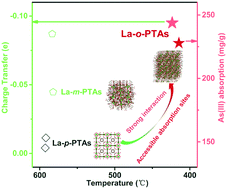Tuning the effective utilization of adsorption sites in La-MOFs via a steric hindrance effect towards enhanced As(iii) removal†
Abstract
The adsorptive removal of highly toxic metal oxyanions such as arsenic from water remains challenging, and metal–organic frameworks (MOFs) with structural diversity have been regarded as promising adsorbents. Herein, three La-MOF adsorbents, La-p-PTAs, La-m-PTAs and La-o-PTAs with different morphologies, are designed by altering the locations of the –COOH group for efficient removal of As(III). In particular, the maximum As(III) adsorption capacity of La-o-PTAs reaches 233.2 mg g−1 within 30 min, which is 22.3% and 51.7% higher than those of La-m-PTAs and La-p-PTAs, respectively. Due to more abundant accessible adsorption sites distributed in the surface and edge regions confirmed by TPO-O2 measurements and stronger interaction demonstrated by XPS analysis, La-o-PTAs have increased utilization of adsorption sites, contributing to the removal of As(III). Additionally, based on density functional theory (DFT) calculations, the adsorption energy of La-o-PTAs is −0.74 eV, 7.2% and 27.6% lower than those of La-m-PTAs and La-p-PTAs, indicating the superior As(III) adsorption performance of La-o-PTAs. This work highlights the critical importance of adsorption site utilization for efficient metal oxyanion remediation.



 Please wait while we load your content...
Please wait while we load your content...